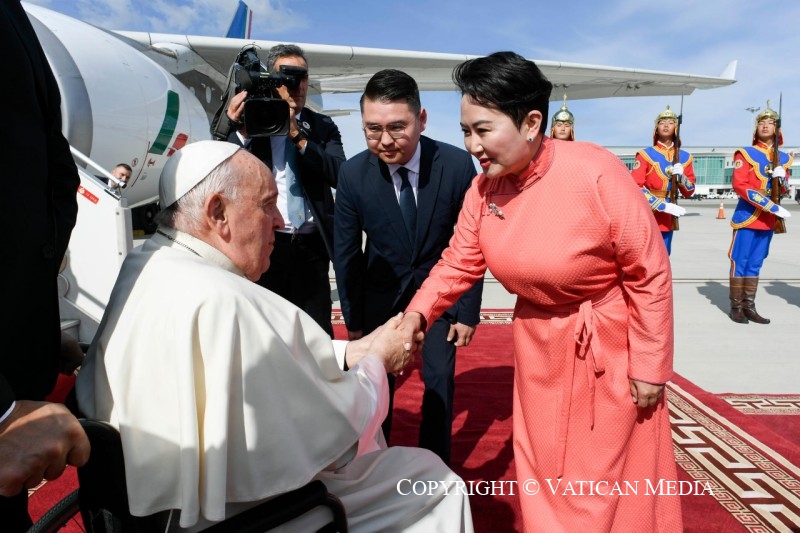Pope Francis arrives in Mongolia
Pope Francis has arrived in Mongolia‘s capital, Ulaanbaatar, effectively kicking off his 43 international Apostolic Journey that ends on 4 September.
The ITA Airways flight carrying Pope Francis to Mongolia, a “land of silence”, he said chatting to journalists on board the plane after take-off on Thursday evening, “a land so vast, so big. It will help us understand what it means: not intellectually but with the senses“, landed shortly before 10 am local time.
The Pope was welcomed at Ulaanbaatar‘s international Chinggis Khaan airport by Monsignor Fernando Duarte Barros Reis, Chargé d‘affaires at Mongolia‘s Apostolic Nunciature, and by the Ambassador of Mongolia to the Holy See, Ms Davaasuren Gerelmaa, and then by Church and government delegations, awaiting him on the tarmac.
The Mongolian State Honour Guard proudly held rank in their red, blue and yellow uniforms and iron helmets that recall Mongolian warriors of ancient history.
During a brief welcome ceremony at the airport, a young Mongolian woman in traditional dress offered the Pope a cup containing “Aaruul“ – boiled yoghurt – made from the milk of cattle, yaks and camels, and symbolizing the nomadic culture of the Mongolian people as it one of their most common travel provisions.
Pope Francis graciously accepted the cup and took a big bite of curd.
The Pope is scheduled to rest on Friday after the long flight. His official meetings and events begin on Saturday morning.

The Church in Mongolia
The East Asian nation the Pope has chosen to visit during his 43rd Apostolic Journey abroad, is the second largest landlocked country in the world (after Kazakstan). Its tiny, traditionally nomadic population, counts less than 3.5 million people; less than 2 percent are Christians.
After 70 years of communist regime, a satellite nation of the USSR, Mongolia underwent a peaceful revolution in 1990 and established a multi-party democracy. It adopted a new Constitution that guarantees religious freedom.
That’s when the Catholic missionaries who had been exiled during the years of communism came back into the country with the task of rebuilding the Church from scratch. Today there are no more than 8 parishes and about 1,500 baptized Catholics.
But they are welcome and integrated and appreciated by authorities and by the people also thanks to the many social, health care and educational programmes they run for the poor, the elderly, the disabled, and the abandoned.
The young Church is headed by the College of Cardinals’ youngest Cardinal, Giorgio Marengo, whom Pope Francis elevated to Cardinal during the Consistory in August 2022.
Source: vaticannews.va





